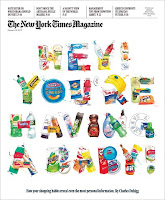THE New York Times Magazine made people nervous with its February 19th cover story by author Charles Duhigg. Its chilling headline, “How Companies Learn Your Secrets,” seems to have compelled readership as a matter of personal protection. I make this inference from the number of acquaintances who asked me about it.
[Author’s Note: This column was originally published on March 13, 2012 in the TradeInsight CPG Chatter blog.]
“Creepy” was the adjective repeated most from individuals who read about how Target Stores applied data mining techniques to shopping baskets to infer which shoppers were most likely pregnant, then sent them promotional offers for pre- and post-natal products. Motherhood is pretty personal business, so I can’t say I disagree with the folks who were offended. What gives them the right?
Focusing on this creepy surveillance was a pretty crafty editorial decision by the editors at NYT Magazine, who used the cover line: “Hey! You’re Having A Baby!” The analytics behind pregnancy detection was actually just one example from Mr. Duhigg’s just-released book “The Power of Habit: Why We Do What We Do in Life and Business.” Having a baby, as it turns out, is one of a handful of predictable moments in life when our consumption habits change big time. For eager marketers that information is, well, mother’s milk.
Even if we look past the intrusiveness of offering coupons for cocoa butter lotion to stretchy young mothers-to-be, Mr. Duhigg’s larger thesis about the enduring nature of habit remains compelling in a different, less sensational way.
It tends to strengthen my own observations of long-lasting retail shopper behaviors, such as trip planning, coupon clipping, list-making and response to promotional cues within the store. In “Shoppers’ Perspective,” research I helped co-author for CPG manufacturer Henkel USA in 2009, we learned that shoppers could be sorted into fairly stable groups based on these enduring habits. It took the pain of the subsequent economic downturn to disrupt the patterns. As a result, coupon redemption statistics turned upward to what we may hypothesize to be a new norm.
The central example of the Duhigg article – Target’s effort to target “new natals” in its promotion marketing – is interesting too, but it offers little, truly new insight about behavioral segmentation analytics. Food, drug and mass retailers have understood the buying traits of new and soon-to-be parents (and other behavioral segments) for decades, without the need for sophisticated data mining tools. These insights are easily inferred from examining the contents of shopping baskets from the store’s point-of-sale transaction records – or better, from frequent shopper data.
It is not necessary to know individual identities, but such knowledge does enable the delivery of more personalized offers and services. These may be welcomed by opt-in frequent shoppers, but can be downright creepy when they seem to be the outcome of cyber-stalking.
The NYT Magazine editors correctly surmised that an article excerpted from Mr. Duhigg’s book could quite possibly be a snooze for readers not already fascinated by human behavior, retail analytics and segmentation and targeting. So they focused – perhaps a bit unfairly – on Target’s stalker-ish behavior toward new moms.
For us retail pros, however, divining the nature of repeat behavior is solid stuff – part of our every day thought work. It reminds us that when we try to influence purchase behavior positively, we also take on the challenge of overcoming pre-existing habit.
© Copyright 2012 James Tenser


